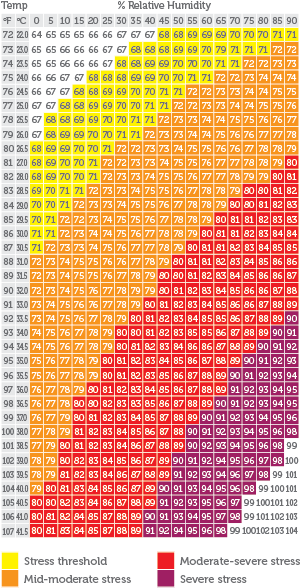Effective heat stress management for cattle: A comprehensive approach
In the arid landscapes of Australian farming, one of the pressing challenges faced by livestock is heat stress. This occurs when the mercury rises and humidity levels soar, making it difficult for cattle to regulate their body temperature. To address this concern and ensure the well-being of your herd, we offer practical insights and strategies to help mitigate heat stress, looking at three key areas: On-farm, livestock management, and nutrition.
Understanding heat stress: The Temperature-Humidity Index (THI)
Before we delve into the practical strategies to manage heat stress effectively, it’s essential to grasp the fundamentals of this challenge. Heat stress is assessed and quantified through a scientific metric known as the Temperature-Humidity Index (THI). This index takes into account not only the air temperature but also the prevailing humidity levels. It is an indispensable tool for gauging the level of discomfort that livestock, particularly cattle, may experience in response to rising temperatures.
What makes heat stress especially noteworthy is its potential to manifest at surprisingly moderate THI levels. In fact, this thermal discomfort can take hold when the THI is as low as 23 degrees Celsius. This fact underscores the importance of proactive heat stress management, as its onset can occur even during conditions that may initially seem mild. As the THI rises, the risk of heat stress becomes increasingly pronounced, necessitating a comprehensive approach to ensure the well-being of your herd and maintain the overall productivity of your farm.
Tools for on-farm heat stress mitigation
We recommend the following hands-on, practical strategies to ensure that your animals are best protected against heat stress:
- Shade: Providing ample shade is a straightforward yet effective approach. During the hottest hours around noon, ensure that cattle have access to shaded areas. A recommended space of approximately 12 square metres per head is advisable to prevent overcrowding, which can exacerbate heat stress.
- Ventilation: In areas where cattle are sheltered, proper ventilation is crucial. Adequate airflow helps maintain a comfortable environment and prevents the accumulation of stagnant, hot air.
- Sprinklers or misters: Sprinkler and mister systems are effective tools for cooling cattle during periods of heat stress. They achieve this through rapid evaporation of water droplets, which in turn absorbs heat from the surroundings, resulting in an immediate temperature drop. This cooling process creates a more comfortable environment for the cattle, alleviating their stress significantly, especially during peak heat. They are particularly valuable during the hottest hours of the day when the risk of heat stress is at its highest. By establishing a localised area of comfort, they offer cattle a refuge from the most intense heat, effectively forming a microclimate that provides essential respite.
- Drinking water: It seems obvious but ensuring that cattle stay well-hydrated is paramount. High-production dairy cows can consume more than 130 litres of water daily. To facilitate optimal hydration, provide ample water troughs near the dairy. Cows tend to drink about 50% of their daily water requirements immediately after milking, so accessibility to water during this time is crucial. All of the above measures are of significant importance in dairy settings, where cows often spend substantial portions of their day in holding yards.
Effective management tools for heat stress mitigation
Aside from the physical on-farm environment practicalities, livestock management strategies can greatly reduce the risk of heat stress:
- Alter milking times: During hotter months, consider adjusting your milking schedule to avoid the peak heat of the day. This reduces the amount of time cattle spend walking in intense heat, thereby minimising their discomfort.
- Grazing practices: Revise your grazing routine to ensure cattle have access to shade during peak heat hours. Implementing on-off grazing, where cattle graze during cooler periods and rest in shaded areas with easy access to fodder during the hottest parts of the day, can be a practical approach.
- Feeding times: Modify your feeding schedule to avoid peak digestion during sweltering daytime hours. This can help reduce internal heat generated by digestion.
Nutritional strategies
The third important focus in heat stress mitigation is nutrition. Nutrition plays a pivotal role in effective heat stress management for cattle. During periods of elevated temperatures, heat stress can reduce feed intake, leading to a potential decline in production. Proper nutrition strategies can help counteract this effect.
- Increase nutrient density: When combating heat stress, it’s essential to enhance the nutrient density of your cows’ rations. This helps maintain production levels despite reduced feed intake. Incorporating both protected and unprotected fats into their diet can increase energy density. Additionally, feeding higher-quality forage and fodder is essential.
- Enhance buffering: Heat stress accelerates respiration and panting, reducing rumination time and saliva production. This leads to a decrease in bicarbonate levels in the blood. Counteract this by increasing buffering in the diet.
- Modify mineral content: Adjust the mineral content of your cows’ ration by increasing sodium, potassium, and magnesium levels. This can help them better cope with heat stress.
- Add betaine: Incorporate betaine into the ration. Betaine is a methyl donor that reduces energy expenditure and helps maintain osmotic balance, offering practical support during periods of heat stress.
Addressing heat stress is a science and an essential aspect of cattle farming. By implementing these on-farm tools, management strategies, and nutritional enhancements, you strengthen your herd against the challenges posed by heat.
Source: University of Arizona
Our team of experts at Reid Stockfeeds can assist you in formulating rations with increased nutrient density, proper buffering agents, and other nutritional strategies to support your herd’s health and productivity during heat stress events. With a commitment to excellence and a deep understanding of agricultural needs, Reid Stockfeeds is here to be your trusted partner in navigating the complexities of heat stress management.
To find out more, give us a call and have a chat to one of our nutritionist on 1300 REID FEED or enquire here >
Author
Tom Fitzgerald
Account Manager – Ruminant

